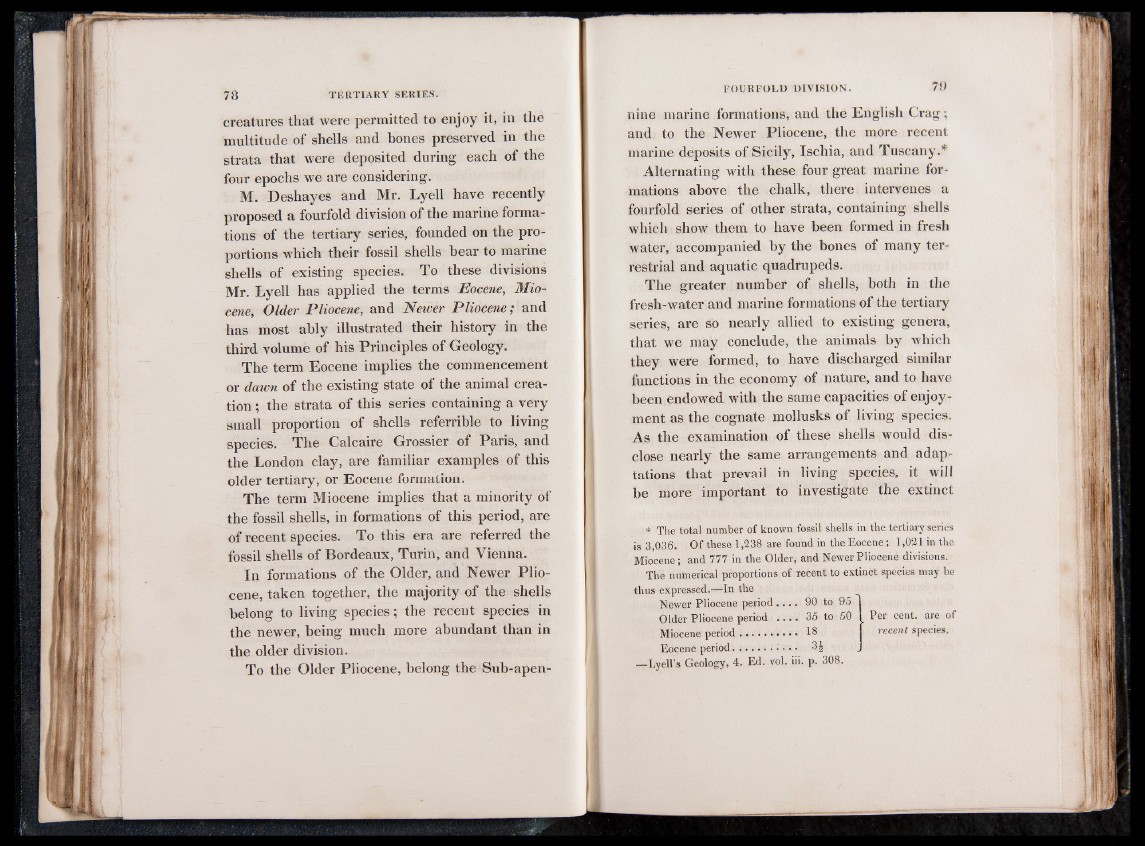
creatures that were permitted to enjoy it, in the
multitude of shells and bones preserved in the
strata that were deposited during each of the
four epochs we are considering.
M. Deshayes and Mr. Lyell have recently
proposed a fourfold division of the marine formations
of the tertiary series, founded on the proportions
which their fossil shells bear to marine
shells of existing species. To these divisions
Mr. Lyell has applied the terms Eocene, Miocene,
Older Pliocene, and Newer Pliocene; and
has most ably illustrated their history in the
third volume of his Principles of Geology.
The term Eocene implies the commencement
or dawn of the existing state of the animal creation
; the strata of this series containing a very
small proportion of shells referrible to living
species. The Calcaire Grossier of Paris, and
the London clay, are familiar examples of this
older tertiary, ôr Eocene formation.
The term Miocene implies that a minority of
the fossil shells, in formations of this period, are
of recent species. To this era are referred the
fossil shells of Bordeaux, Turin, and Vienna.
In formations of the Older, and Newer Pliocene,
taken together, the majority of the shells
belong to living species ; the recent species in
the newer, being much more abundant than in
the older division.
To the Older Pliocene, belong the Sub-apen-
FOURFOLD DIVISION. 79
nine marine formations, and the English Crag ;
and to the Newer Pliocene, the more recent
marine deposits of Sicily, Ischia, and Tuscany *
Alternating with these four great marine formations
above the chalk, there intervenes a
fourfold series of other strata, containing shells
which show them to have been formed in fresh
water, accompanied by the bones of many terrestrial
and aquatic quadrupeds.
The greater number of shells, both in the
fresh-water and marine formations of the tertiary
series, are so nearly allied to existing genera,
that we may conclude, the animals by which
they were formed, to have discharged similar
functions in the economy of nature, and to have
been endowed with the same capacities of enjoyment
as the cognate mollusks of living species.
As the examination of these shells would disclose
nearly the same arrangements and adaptations
that prevail in living species, it will
be more important to investigate the extinct
* The total number of known fossil shells in the tertiary series
is 3,036. Of these 1,238 are found in the Eocene; 1,021 in the
Miocene; and 777 in the Older, and Newer Pliocene divisions.
The numerical proportions of recent to extinct species may be
thus expressed.—In the
Newer Pliocene period . . . . 90 to 95
Older Pliocene period . . . . 35 to 50 Per cent, are of
Miocene period ..................... 16 recent species,
Eocene period........... • • • • • 3 J J-
—Lyell’s Geology, 4. Ed. voi. iii. p. 308.